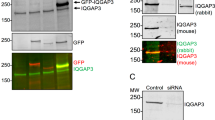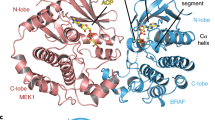Abstract
Fine tuning of Ras activity is widely known as a mechanism to induce different cellular responses. Recently, we have shown that calmodulin (CaM) binds to K-Ras and that K-Ras phosphorylation inhibits its interaction with CaM. In this study we report that CaM inhibits K-Ras phosphorylation at Ser181 by protein kinase C (PKC) in vivo, and this is a mechanism to modulate K-Ras activity and signaling. Although CaM inhibition increased the activation of endogenous K-Ras, PKC inhibition decreased its activation status. We demonstrate that K-Ras phosphorylation decreased susceptibility to p120GAP activity. Accordingly, we also observed that non-phosphorylable K-Ras mutant exhibits a less sustained activation profile and do not efficiently activate AKT at low growth factor doses compared with wild-type K-Ras. It is interesting that the physiological responses induced by K-Ras are affected by this phosphorylation; when K-Ras cannot be phosphorylated it exhibits a remarkably decreased ability to stimulate proliferation in non-saturated serum conditions. Finally, we demonstrate that phosphorylation also regulates oncogenic K-Ras functions, as focus formation capacity, mobility and apoptosis resistance upon adriamycin treatment of cells expressing oncogenic K-Ras that cannot be phosphorylated are highly compromised. Moreover, at low serum concentration proliferation and survival is practically inhibited when cells cannot phosphorylate oncogenic K-Ras. In this condition, K-Ras phosphorylation is essential to ensure a proper activation of mitogen-activated protein kinase and PI3K/AKT pathways. In summary, our findings suggest that the interplay between CaM interaction and PKC phosphorylation is essential to regulate non-oncogenic and oncogenic K-Ras activity and functionality.
This is a preview of subscription content, access via your institution
Access options
Subscribe to this journal
Receive 50 print issues and online access
$259.00 per year
only $5.18 per issue
Buy this article
- Purchase on Springer Link
- Instant access to full article PDF
Prices may be subject to local taxes which are calculated during checkout









Similar content being viewed by others
References
Agell N, Bachs O, Rocamora N, Villalonga P . (2002). Modulation of the Ras/Raf/MEK/ERK pathway by Ca(2+), and calmodulin. Cell Signal 14: 649–654.
Agell N, Jaumot M, Rodriguez-Vilarrupla A, Brun S, Abella N, Canela N et al. (2006). The diverging roles of calmodulin and PKC in the regulation of p21 intracellular localization. Cell Cycle 5: 3–6.
Ashery U, Yizhar O, Rotblat B, Elad-Sfadia G, Barkan B, Haklai R et al. (2006). Spatiotemporal organization of Ras signaling: rasosomes and the galectin switch. Cell Mol Neurobiol 26: 471–495.
Ballester R, Furth ME, Rosen OM . (1987). Phorbol ester- and protein kinase C-mediated phosphorylation of the cellular Kirsten ras gene product. J Biol Chem 262: 2688–2695.
Bivona TG, Quatela SE, Bodemann BO, Ahearn IM, Soskis MJ, Mor A et al. (2006). PKC regulates a farnesyl-electrostatic switch on K-Ras that promotes its association with Bcl-XL on mitochondria and induces apoptosis. Mol Cell 21: 481–493.
Bos JL . (1989). Ras oncogenes in human cancer. Cancer Res 49: 4682–4689.
Bosch M, Gil J, Bachs O, Agell N . (1998). Calmodulin inhibitor W13 induces sustained activation of ERK2 and expression of p21(cip1). J Biol Chem 273: 22145–22150.
Chakravarthy B, Morley P, Whitfield J . (1999). Ca2+-calmodulin and protein kinase Cs: a hypothetical synthesis of their conflicting convergences on shared substrate domains. Trends in Neurosci 22: 12–16.
Downward J . (1996). Control of ras activation. Cancer Surv 27: 87–100.
Downward J, Graves JD, Warne PH, Rayter S, Cantrell DA . (1990). Stimulation of p21ras upon T-cell activation. Nature 346: 719–723.
Drosten M, Dhawahir A, Sum EY, Urosevic J, Lechuga CG, Esteban LM et al. (2010). Genetic analysis of Ras signalling pathways in cell proliferation, migration and survival. EMBO J 29: 1091–1104.
Elad-Sfadia G, Haklai R, Balan E, Kloog Y . (2004). Galectin-3 augments K-Ras activation and triggers a Ras signal that attenuates ERK but not phosphoinositide 3-kinase activity. J Biol Chem 279: 34922–34930.
Elad-Sfadia G, Haklai R, Ballan E, Gabius HJ, Kloog Y . (2002). Galectin-1 augments Ras activation and diverts Ras signals to Raf-1 at the expense of phosphoinositide 3-kinase. J Biol Chem 277: 37169–37175.
Hamilton M, Liao J, Cathcart MK, Wolfman A . (2001). Constitutive association of c-N-Ras with c-Raf-1 and protein kinase C epsilon in latent signaling modules. J Biol Chem 276: 29079–29090.
Hancock JF . (2003). Ras proteins: different signals from different locations. Nat Rev Mol Cell Biol 4: 373–384.
Johnson L, Greenbaum D, Cichowski K, Mercer K, Murphy E, Schmitt E et al. (1997). K-ras is an essential gene in the mouse with partial functional overlap with N-ras. Genes Dev 11: 2468–2481.
Kahan C, Seuwen K, Meloche S, Pouyssegur J . (1992). Coordinate, biphasic activation of p44 mitogen-activated protein kinase and S6 kinase by growth factors in hamster fibroblasts. Evidence for thrombin-induced signals different from phosphoinositide turnover and adenylylcyclase inhibition. J Biol Chem 267: 13369–13375.
Klee C, Vanaman T . (1982). Calmodulin. Adv Protein Chem 35: 213–321.
Liao J, Planchon SM, Wolfman JC, Wolfman A . (2006). Growth Factor-dependent AKT Activation and Cell Migration Requires the Function of c-K(B)-Ras versus other cellular Ras isoforms. J Biol Chem 281: 29730–29738.
Liou JS, Chen JS, Faller DV . (2004). Characterization of p21Ras-mediated apoptosis induced by protein kinase C inhibition and application to human tumor cell lines. J Cell Physiol 198: 277–294.
Lopez-Alcala C, Alvarez-Moya B, Villalonga P, Calvo M, Bachs O, Agell N . (2008). Identification of essential interacting elements in K-Ras/calmodulin binding and its role in K-Ras localization. J Biol Chem 283: 10621–10631.
Lu KP, Means AR . (1993). Regulation of the cell cycle by calcium and calmodulin. Endocrine Rev 14: 40–58.
Malumbres M, Barbacid M . (2003). RAS oncogenes: the first 30 years (vol 3, pg 459, 2003). Nat Rev Cancer 3: 708.
Marshall C . (1999). How do small GTPase signal transduction pathways regulate cell cycle entry? Curr Opin Cell Biol 11: 732–736.
Marshall CJ . (1995). Specificity of receptor tyrosine kinase signaling: transient versus sustained extracellular signal-regulated kinase activation. Cell 80: 179–185.
Matallanas D, Sanz-Moreno V, Arozarena I, Calvo F, Agudo-Ibanez L, Santos E et al. (2006). Distinct utilization of effectors and biological outcomes resulting from site-specific Ras activation: Ras functions in lipid rafts and Golgi complex are dispensable for proliferation and transformation. Mol Cell Biol 26: 100–116.
Moreto J, Llado A, Vidal-Quadras M, Calvo M, Pol A, Enrich C et al. (2008). Calmodulin modulates H-Ras mediated Raf-1 activation. Cell Signal 20: 1092–1103.
Omerovic J, Laude AJ, Prior IA . (2007). Ras proteins: paradigms for compartmentalised and isoform-specific signalling. Cell Mol Life Sci 64: 2575–2589.
Plowman SJ, Ariotti N, Goodall A, Parton RG, Hancock JF . (2008). Electrostatic interactions positively regulate K-Ras nanocluster formation and function. Mol Cell Biol 28: 4377–4385.
Prior IA, Muncke C, Parton RG, Hancock JF . (2003). Direct visualization of Ras proteins in spatially distinct cell surface microdomains. J Cell Biol 160: 165–170.
Pumiglia KM, Decker SJ . (1997). Cell cycle arrest mediated by the MEK/mitogen-activated protein kinase pathway. Proc Natl Acad Sci USA 94: 448–452.
Qui MS, Green SH . (1992). PC12 cell neuronal differentiation is associated with prolonged p21ras activity and consequent prolonged ERK activity. Neuron 9: 705–717.
Rodriguez-Vilarrupla A, Jaumot M, Abella N, Canela N, Brun S, Diaz C et al. (2005). Binding of calmodulin to the carboxy-terminal region of p21 induces nuclear accumulation via inhibition of protein kinase C-mediated phosphorylation of Ser153. Mol Cell Biol 25: 7364–7374.
Roovers K, Assoian RK . (2000). Integrating the MAP kinase signal into the G1 phase cell cycle machinery. Bioessays 22: 818–826.
Schulman H . (1993). The multifunctional Ca2+/calmodulin-dependent protein kinases. Curr Opin Cell Biol 5: 247–253.
Shalom-Feuerstein R, Plowman SJ, Rotblat B, Ariotti N, Tian T, Hancock JF et al. (2008). K-ras nanoclustering is subverted by overexpression of the scaffold protein galectin-3. Cancer Res 68: 6608–6616.
Umanoff H, Edelmann W, Pellicer A, Kucherlapati R . (1995). The murine N-ras gene is not essential for growth and development. Proc Natl Acad Sci USA 92: 1709–1713.
Veigl ML, Sedwick WD, Vanaman TC . (1982). Calmodulin and Ca2+ in normal and transformed cells. Fed Proc 41: 2283–2288.
Villalonga P, López-Alcalá C, Bosch M, Chiloeches A, Rocamora N, Gil J et al. (2001). Calmodulin binds to K-RAs but H- or N-Ras, and modulates its downstream signaling. Mol Cell Biol 21: 7345–7354.
Villalonga P, Lopez-Alcala C, Chiloeches A, Gil J, Marais R, Bachs O et al. (2002). Calmodulin prevents activation of Ras by PKC in 3T3 fibroblasts. J Biol Chem 277: 37929–37935.
Xia S, Chen Z, Forman LW, Faller DV . (2009). PKCdelta survival signaling in cells containing an activated p21Ras protein requires PDK1. Cell Signal 21: 502–508.
Xia S, Forman LW, Faller DV . (2007). Protein kinase C delta is required for survival of cells expressing activated p21RAS. J Biol Chem 282: 13199–13210.
Yan J, Roy S, Apolloni A, Lane A, Hancock JF . (1998). Ras isoforms vary in their ability to activate Raf-1 and phosphoinositide 3-kinase. J Biol Chem 273: 24052–24056.
Acknowledgements
We thank Dr M Barbacid (CNIO, Spain) for the generous gift of Rasless and K-Ras−/− MEFs. We are also indebt with Anna Bosch and Maria Calvo (Confocal microscopy facility, SCT-University of Barcelona) for their help of performing the cell mobility assays. This study was supported by grant SAF2007-60491 from the Ministerio de Educación y Ciencia (Spain). Blanca Alvarez-Moya was recipient of a pre-doctoral fellowship from the Generalitat de Catalunya (Spain).
Author information
Authors and Affiliations
Corresponding author
Ethics declarations
Competing interests
The authors declare no conflict of interest.
Additional information
Supplementary Information accompanies the paper on the Oncogene website
Rights and permissions
About this article
Cite this article
Alvarez-Moya, B., López-Alcalá, C., Drosten, M. et al. K-Ras4B phosphorylation at Ser181 is inhibited by calmodulin and modulates K-Ras activity and function. Oncogene 29, 5911–5922 (2010). https://doi.org/10.1038/onc.2010.298
Received:
Revised:
Accepted:
Published:
Issue Date:
DOI: https://doi.org/10.1038/onc.2010.298
Keywords
This article is cited by
-
ROS production by mitochondria: function or dysfunction?
Oncogene (2024)
-
The role of ral signaling and post translational modifications (PTMs) of Ras in cancer
Genome Instability & Disease (2022)
-
KRAS phosphorylation regulates cell polarization and tumorigenic properties in colorectal cancer
Oncogene (2021)
-
Molecular genetics and cellular events of K-Ras-driven tumorigenesis
Oncogene (2018)
-
A model for RAS mutation patterns in cancers: finding the sweet spot
Nature Reviews Cancer (2018)



